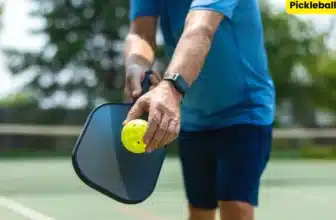
Ever found yourself on the pickleball court wondering, What if there’s a secret sauce to spice up my doubles game?” Well, good news for you as we are about to learn everything about the secret weapon in a pickleball game, pickleball Stacking!
Whether you’re a pickleball pro or a rookie to the game, learning about pickleball stacking might just be the game changer you have been seeking. Let’s learn what makes pickleball stacking tick, and explore the rules and strategic finesse that make it a standout approach in the world of doubles play.
What is Stacking in Pickleball?
Pickleball stacking is more than just a fancy term tossed around the pickleball courts. Stacking in pickleball is actually a dynamic strategy that spices up the traditional doubles format.
Pickleball Stacking is not as complex as it might sound. Stacking is a trick where doubles teams begin the game on the same side, offering a unique approach to court positioning. Normally, players stand on opposite sides, but stacking allows them to choose sides strategically based on individual strengths and the flow of the game.

Let’s simplify it:
- Court Dynamics in Doubles Setup:
- One player behind the baseline.
- The other at the non-volley zone (NVZ) line.
- Traditional Doubles Arrangement:
- Serving from the baseline.
- Returner positioned near the NVZ line.
- Pickleball Stacking
- Game begins with a twist.
- Both players start on the same side.
What is the purpose of stacking in pickleball?
The primary goal of stacking lies in strategic optimization. Stacking allows both teammates to start the game from the same side and shift positions when required. Hence, stacking enables players to tailor their gameplay according to their individual strengths.
The sole purpose of this trick is to disrupt opponents’ expectations, play according to one’s own strengths, and add an extra touch of unpredictability to the game.
How Does Stacking Work?
Curious about the nitty-gritty of pickleball stacking rules and mechanics? Fear not, because we have got you covered.
- Stacking on the serve involves starting on the traditional right-hand (even) side, with the server behind the baseline and the non-serving partner to their right.
- After scoring a point, the server moves to the left-hand (odd) side, and their teammate adjusts accordingly.
The beauty of this trick lies in the seamless transition back to preferred positions. The pickleball stacking diagram given right below will help you understand it in a much better way.

But what about stacking when returning a serve? Instead of the conventional positioning near the baseline for the returner and at the NVZ line for their partner, stacking introduces a fresh perspective. The partner waits strategically out of bounds beyond the right-hand sideline. Upon return, both players slide to the left, providing a strategic advantage and keeping opponents on their toes.
Switching and Stacking:
Pickleball players might have encountered the terms “switching” and “stacking” used interchangeably in a pickleball court, but these are distinct moves. Switching, often occurring on the return of serve, involves the non-receiver moving to the other side. This enhances court coverage.
In contrast, stacking is a broader strategy. What it does is that it allows the players to quickly switch sides during play. Imagine combining both – a coordinated practice that keeps opponents guessing what the next move of the players will be.
But how do players communicate during these tactical maneuvers? All thanks to pickleball stacking hand signals. These discrete signals, like an open hand for a switch and a closed fist for staying put, facilitate seamless coordination. Some clever teams even throw in fake signals to add an element of surprise and create scoring opportunities.
Is Stacking Allowed in Pickleball?

Before exploring other details, let’s address a common question: Is stacking legal? According to the 2024 USA Pickleball Official Rulebook, stacking is entirely legal. With some specific rules for serving, stacking provides players the flexibility to position themselves strategically, adding an extra layer of excitement to the game.
But does handedness matter in stacking? Absolutely. A player being left-handed can be a driving force behind stacking, ensuring both teammates’ forehands face the center of the court for maximum impact.
Half Stacking vs. Full Stacking:
On a pickleball court, you may have come across a few terms like half stacking and full stacking.
Let’s explore these terms a but in detail:
- Half Stacking:
- Use stacking only when you’re serving.
- Keeps things simpler, especially during the return.
- Good if you prefer an easier strategy.
- Full Stacking:
- Stack both when serving and returning.
- More versatile but needs a better understanding of the game and coordination.
- Suitable for those ready for a bit more complexity in their game.
Mastering Pickleball Stacking: Tips and Tricks
Now that we have uncovered the details of pickleball stacking, it’s finally the time to learn a few tips and tricks to master this dynamic strategy:
- Create time and space for your team to move
- Perform deep service returns with less pace and a bit of arc to ensure a smooth transition during stacking.
- Be aware of gaps
- Anticipate potential open spaces that opponents might exploit as you shift positions during stacking.
- Remember the score
- Stay ahead by keeping track of the score to plan offensive and defensive strategies accordingly.
- Be prepared to stop
- In the midst of movement, be ready to halt and split-step for precise shots before continuing into the correct position.
Bottom Line
Simply put, stacking in pickleball is like a smart move that lets players start on one side and smoothly switch places during the game. It is a clever trick in your game plan, waiting for the right moment to shine.
FAQs
What happens if I forget my position while stacking?
No worries! According to pickleball rules, you can ask the referee for guidance on your position
Is there a limit to how many times we can stack?
There’s no limit; feel free to incorporate stacking as much as you’d like.
How do you stack in pickleball?
Traditional stacking involves receiving the serve, and post-return, both players shift to the left on the court. Experiment with this strategy to add versatility to your gameplay.






